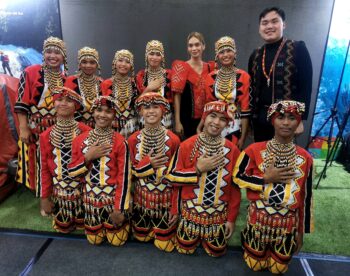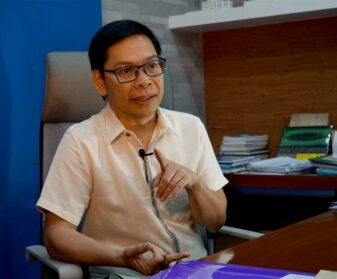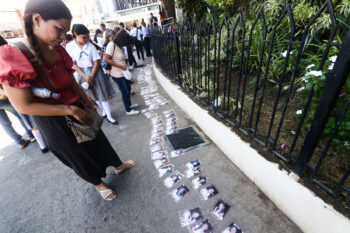I was just checking out the latest postings on my Facebook wall, when I noticed an interesting article in Huffington Post about the “15 Places To Go Before They Get Famous”.
Accessing the data, I read that the list included: Jose Igacio, Uruguay; Koh Rong, Cambodia; Sofia, Bulgaria; Ambergris Caye, Belize; Myanmar; Roatán, Honduras; Riga, Latvia; Puglia, Italy; Zambia and Zimbabwe; York, United Kingdom; Busan, South Korea; Manila, Philippines; Phu Quoc, Vietnam’ Kep, Cambodia and The Salinas Grandes, Argentina.
Manila, Philippines? Who are they kidding? Especially in the hot summer season?
No, go instead to Surigao del Sur (or Double Sur, which is better-sounding than SurSur). In this part of the archipelago, the local tourist is afforded a double treat: a cluster of some of the most beautiful sights in this country and affordable prices given the tourists’ very tight budgets. I have the audacity to claim this as I have been to many corners of our country (from north to south, east to west) and I took a vow of poverty (read: I do not have deep pockets).
And go to these places now before they get famous; once these spots become popular, the sights would have lost their pristine beauty and only the foreign and rich tourists could afford the fees. It is starting to happen already and in the case of the Enchanted River in Hinatuan, there are far too many people crowding the tight space during week-ends of the summer months; consequently, its mystical, magical charm has been heavily eroded. It is heart-breaking to see how this enchanted river is slowly breaking apart, causing a disenchantment to those who come with the hope of encountering an abode of the diwatas! (But this is another story.)
For Mindanawons, there is no need to go to Palawan to experience the delights of El Nido or up in Coron. Those places, too, are starting to be too crowded and expensive. We can just go off to Double Sur, located along the northeastern coast of Mindanao facing the Pacific Ocean. This is an elongated province extending from Carrascal in the north to the southernmost town of Lingig, stretching approximately 300 kilometers in length and 50 kilometers at its widest point which runs from Cagwait to San Miguel. Given the zig-zagging contours of the seacoasts, Double Sur has many bays and coves, islands and islets including those that vanish when it is high tide.
With a few surrogate children and grandchildren, we recently explored some of these sights and at the end of our three-day sojourn, we all decided we would return to Double Sur when we next have the luxury of such a break! After this recent vacation, we concluded that it was such a thrill to have discovered these places right here in our own island, beyond the usual vacation spots in the Davao, Cotabato, Bukidnon, Misamis and Zamboanga Regions. (We know, of course, that the other location we are dying to explore is the vast seascape between Jolo and Sabah with all those fabled islands in the sun! But, until the peace process guarantees safety for the travelers there, the use of the word dying might take on a far too literal meaning. That, too, is another story which may turn tragic).
Why Double Sur? Because the sights are indeed awesome; almost at par with those in north Palawan. There is a variety of land- and seascapes; with a rich variety of moods, shapes and colors. And since one is travelling on land, travel to these sights are relatively inexpensive; one need not book tickets ahead of time. Costs are also affordable as these are places mainly visited by local tourists; there are still few foreign tourists whose presence jack up the board and lodging prices considerably. Practically all these spots are LGU-administered which keep entrance costs low. (However, the shadow part is that being LGU-managed, one has to be considerate in terms of the maintenance quality of these spots).
If one has only three days to explore Double Sur, the tour could involve this package (the order could be reversed depending on where the person takes off; as one could reach Double Sur from Butuan or Surigao Norte in the northeast, or Davao in the southwest):
Day 1: Reach the town of San Agustin as early as possible to be at the resorts in Barangay Britania by lunch. There is an entrance fee of PhP 25. There are a few resorts one could choose from where tourists can book for an overnight stay. (Note to the LGU: please take away the ugly tarpaulins advertising the resorts; they are eyesores!) As fishing is the main livelihood here, there is seafood galore and the resorts have restaurants. (If this is your last stop, one could buy shells as pasalubong; prices are one-tenth compared to those in Bangkerohan market).
Amenities are still basic; but who needs such affluence when nature’s beauty is awesome! (Sorry millennials; wi-fi is non-existent!) If you arrive at Britania at low tide, one needs to walk a long footbridge to take the pumpboat ride. A whole day’s trip around the bay costs PhP 1,500. These pumpboats are owned by the resorts and are available day and night; on a moonlit night, one can imagine that the pumpboat ride is magical! There are more than 20 islands/islets spread across the bay; the ride could involve island-hopping. In some of these, the travelers could ask the pumpboat driver to make a stop so they can take a dip in crystal clear waters. The best is Hagonoy Island – at low tide stretching across half-a-kilometer; with a few coconut trees and bushes at its center – where the sand is as soft as white sugar; one feels like walking on soft carpet. Swimming here is heavenly and since the crowds are still thin even on summer week-ends, one can imagine that one owns the entire island. Riding on the pumpboat back to the mainland, the cloud formations are a sight to behold. If El Nido in Palawan is not affordable for the restless Mindanawon traveler, come to Britania.
Day 2: After breakfast, drive to the Enchanted River in Hinatuan. So you will not be disenchanted, especially during the summer, be there when the gates open at 8 AM when the crowd is still thin. (Off summer and during week-days, the crowds are tolerable.) By mid-morning, abandon the river and explore the bay as the river gets overcrowded (unless you are the type who loves crowds as you can show-off your diving skills). Unfortunately, the feeding of the fish in the river is by 12 noon so you will miss this tourist attraction once you head off for the bay. There are small pumpboats (that can only take in 5 passengers) cruising from the river to the bay (price: PhP 160/hour). The journey from the river to the bay is wonderful; since nature is unmolested, one gets a sense of being surrounded by a mini-forest. The traffic is still light so one does not feel constricted (a complete opposite to the scene at Pagsanjan). There are two floating restaurants at the middle of the bay; attached to these are fish cages where one sees all kinds of fish, including sharks. In one of these restaurants, the central fish cage has these sharks. The owners tell you that the sharks were placed there since they were babies so they are used to swimming with human beings. They guarantee it is very safe to swim with the sharks and the bravehearts take up the challenge. But I had one thought as I swam with the sharks: what if the one of the sharks’ state of mind snaps and remembers its identity, could I be the first to be eaten in this fish cage? (That, too, is another story which may turn out to be a double tragedy.)
After a wonderful lunch (the fish is extra fresh and there are so many ways that the fish could be cooked so one can truly have a sumptuous lunch while floating in the bay; they also serve durian shake!), the place to explore is the vanishing island right at the mouth of the bay. One, however, has to wait for low tide for the vanishing island to appear, along with the giant waves that hit the adjacent coral reefs. This island’s charm parallels that of Camiguin’s white sand bar, except it is smaller and could disappear anytime (which is why tourists should always have their bright orange jackets). As the island is hit by waves from different sides of the bay, one could choose a spot where the waves are small, medium and big. The white sand is not as soft as that of Hagonoy Island in Britania but they are still far superior than those in Samal Island. There are other swimming spots in the bay, but after this vanishing island, the intensity of the thrill dips.
The floating restaurants provide lodging for the night. Prices range from rooms that are air-conditioned (PhP 1,500 for a room with 5 beds) to a small room with one bed (300). Again, on a moonlit night, this place is heavenly. One wakes up in the morning to the sound of gentle waves and birds chirping. For eager bird-watchers, there is a variety of birds that come and perch on the roofs and platforms of the floating restaurant.
Day 3: Drive to Tinuy-an Falls in Bislig. Like the road to Britania, the 20-kilometer road from the highway to the interior is still unpaved which is why the crowds are still manageable. (If and when the roads are cemented, naturally, the crowds will unfortunately expand and if uncontrolled could destroy the habitat.) After Pablo, the main falls is not as majestic (as since we went this summer, there is less water flowing). Still, it can claim to be a mini-Niagara. As with many other waterfalls across the country, there are rafts that connect the people to the spot where they can take a shower under the waters falling close to a hundred feet. One can climb the side of the hill to reach the other layers of the falls above; four of these await those who are willing to hike up the hill. Fortunately, despite the crowd, the place is clean. But the overcrowding is starting to take place and those who arrive late could no longer find kiosks and tents.
Double Sur has far more sights to offer the tourists. Along its costal area, there are more coves and bays with islets but which are not yet accessible given the limited infrastructure of this province which remains one of the poorest in the country. There are caves which have not been transformed into tourist spots. There are remnants of forests where bio-diversity is still intact.
Beyond its natural beauty, Double Sur could expand its tourism potential by showcasing its place in Philippine history as well as in promoting appreciation of indigenous cultures of the Lumads. Double Sur figures prominently in the rise of the Caraga district; since the dawn of the Spanish occupation, galleons from Spain passed through this part of the archipelago. Unlike the Ilocos and Bohol, churches and other old buildings are not as impressive but they have their own cultural value. It is unfortunate that unlike South Cotabato and Marawi, the cultural traditions of the Manobo have been suppressed and their cultural heritage pushed aside. But these have not totally disappeared; like the vanishing islands, they are there just waiting to be rediscovered.
So why spend a fortune to be a tourist in Belize or in Zimbabwe? Why be subjected to the torture of Manila’s traffic? For the Mindanawon tourists, the place to go before it gets famous is Double Sur. It is right under our noses! If one’s advocacy is to make tourism not just a dollar-earner to prop up our economy (but which only benefits foreigners) but to benefit our own people who do need to enjoy a vacation while providing jobs to the local communities, then support the LGUs’ attempts to expand on the tourism potentials in Double Sur. Tangentially, this could also end all the destructive mining and logging operations in this part of Mindanao which have only benefitted those who own the business enterprises and almost totally destroyed the beauty of this location which is not only madayaw, apan sa katahum – kuyaw! (not just good, but a champion in terms of beauty).
(MindaViews is the opinion section of MindaNews. Redemptorist Brother Karl Gaspar of Davao City, former head of the Redemptorist Itinerant Mission Team and author of several books, including “To be poor and obscure,” and “Mystic Wanderers in the Land of Perpetual Departures,” writes two columns for MindaNews, one in English [A Sojourner’s Views] and the other in Binisaya [Panaw-Lantaw].)







